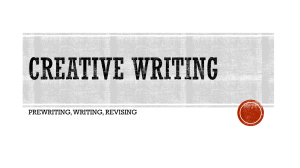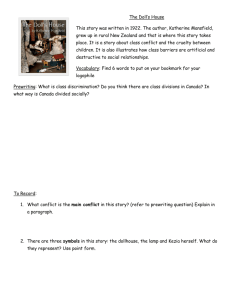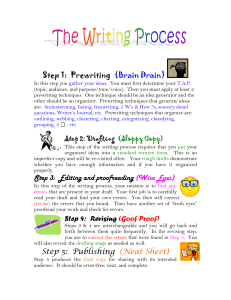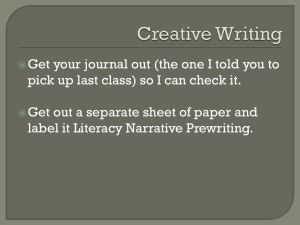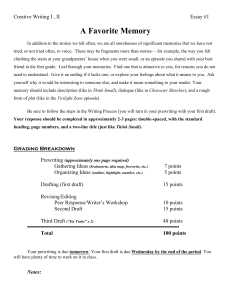Prewriting Techniques: A Guide to Finding Ideas for Writing
advertisement
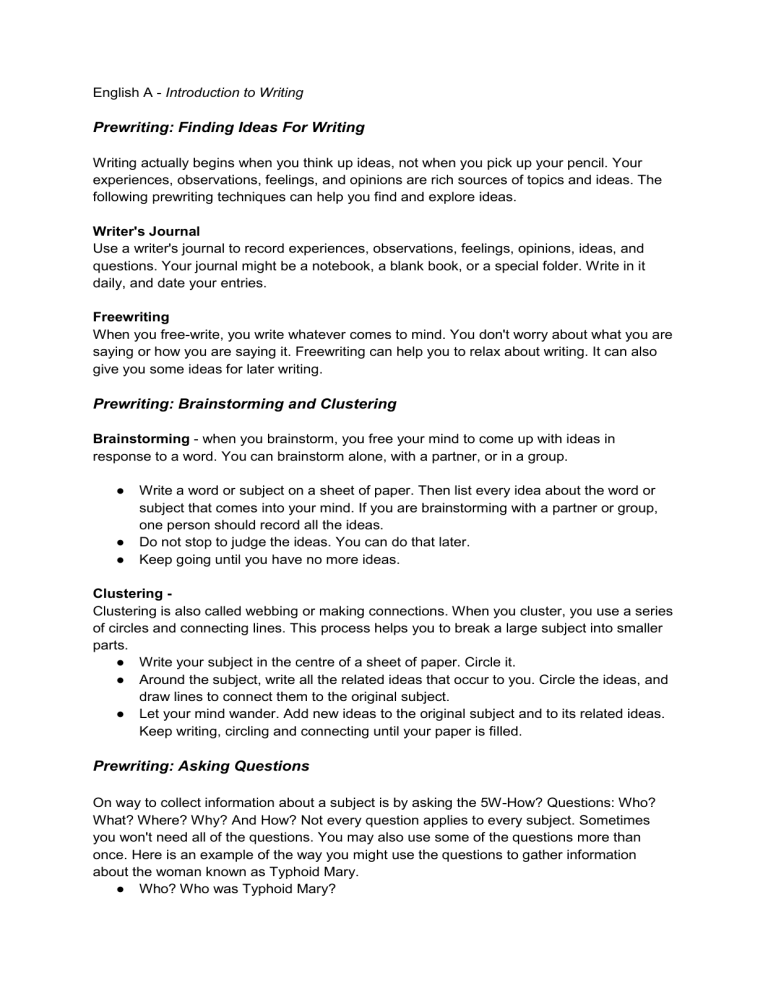
English A - Introduction to Writing Prewriting: Finding Ideas For Writing Writing actually begins when you think up ideas, not when you pick up your pencil. Your experiences, observations, feelings, and opinions are rich sources of topics and ideas. The following prewriting techniques can help you find and explore ideas. Writer's Journal Use a writer's journal to record experiences, observations, feelings, opinions, ideas, and questions. Your journal might be a notebook, a blank book, or a special folder. Write in it daily, and date your entries. Freewriting When you free-write, you write whatever comes to mind. You don't worry about what you are saying or how you are saying it. Freewriting can help you to relax about writing. It can also give you some ideas for later writing. Prewriting: Brainstorming and Clustering Brainstorming - when you brainstorm, you free your mind to come up with ideas in response to a word. You can brainstorm alone, with a partner, or in a group. ● ● ● Write a word or subject on a sheet of paper. Then list every idea about the word or subject that comes into your mind. If you are brainstorming with a partner or group, one person should record all the ideas. Do not stop to judge the ideas. You can do that later. Keep going until you have no more ideas. Clustering Clustering is also called webbing or making connections. When you cluster, you use a series of circles and connecting lines. This process helps you to break a large subject into smaller parts. ● Write your subject in the centre of a sheet of paper. Circle it. ● Around the subject, write all the related ideas that occur to you. Circle the ideas, and draw lines to connect them to the original subject. ● Let your mind wander. Add new ideas to the original subject and to its related ideas. Keep writing, circling and connecting until your paper is filled. Prewriting: Asking Questions On way to collect information about a subject is by asking the 5W-How? Questions: Who? What? Where? Why? And How? Not every question applies to every subject. Sometimes you won't need all of the questions. You may also use some of the questions more than once. Here is an example of the way you might use the questions to gather information about the woman known as Typhoid Mary. ● Who? Who was Typhoid Mary? ● ● ● ● ● What? What did she do to spread Typhoid? Where? Where did she live and work? When? When did this happen? Why? Why did she spread the disease? Why wasn't she cured? How? How was she finally stopped from spreading Typhoid? Asking "What If?" Questions Asking "What If?" questions can help you to generate a variety of ideas for creative writing. You explore what might follow if something occurred. For example: What if something happened to an average person causing them to develop special abilities? This could be the basis of a story. Prewriting: Arranging Ideas After you have gathered ideas you need to spend some time arranging them. There are four common ways to order ideas. Arranging Ideas Type of Order Definition Examples Chronological Narration: order that presents events as they happen in time. Story, narrative poem, explanation of a process, drama, history, biography Spatial Description: order that describes objects according to location Descriptions (near to far, outside to inside, left to right, top to bottom) Importance Evaluation: order that gives details from least to most important or the reverse. Persuasion, descriptions, explanations, evaluation Logical Classification: order that relates items and groups Definitions, classifications Writing A First Draft People take different approaches to drafting. Some write quickly, while others work more slowly and carefully. Some people work with rough drafts whilst some prefer to work based on detailed, thoroughly planned outlines. As you write your first draft, you might try these suggestions: ● Use your prewriting plans as a guide. ● Write freely, and focus on expressing your ideas clearly. ● ● You may discover new ideas as you write. Include these new ideas in your draft. Don't worry too much about grammar or spelling as these errors can be corrected later. Faults in Style to Avoid ● Cliches - a cliche is a phrase or opinion that is overused and betrays a lack of original thought. ● Misplaced metaphor - A metaphor is a figure of speech that, for rhetorical effect, directly refers to one thing by mentioning another. ● Misplaced modifiers - A modifier is a word, especially an adjective or noun used attributively, that restricts or adds to the sense of a head noun (e.g. good and family in a good family house ). In linguistics, a modifier is an optional element in phrase structure or clause structure which modifies the meaning of another element in the structure. A dangling modifier is a type of ambiguous grammatical construct whereby a grammatical modifier could be misinterpreted as being associated with a word other than the one intended. A dangling modifier has no subject and is usually a participle. ● ● ● ● ● Excessive description Unnecessary Shift in Verb Tense - Verbs that shift from one tense to another with no clear reason can confuse readers. Fused (run-on) Sentence - A fused sentence (also called a run-on) joins clauses that could each stand alone as a sentence with no punctuation or words to link them. Long, wordy sentences Sentence Fragment - A sentence fragment is part of a sentence that is presented as if it were a complete sentence. The following illustrate the ways sentence fragments can be created: Without a subject The American colonists resisted British taxation. And started the American Revolution. The American colonists resisted British taxation and started the American Revolution. No complete verb The pink geranium blooming in its pot. Beginning with a subordinating word We visited the park. Where we threw the Frisbee. EXERCISE: 1. Using what you've learned about arranging Ideas in chronological order, draft a narrative about how to do some simple process. 2. Use the techniques you've learned about prewriting to brainstorm/cluster ideas for a possible story based on one of three images. Ask and answer the five W questions about the plot of your story. Finally, draft the first (few) paragraph/s. The draft must be approximately 200 words. a. B. C. Evaluating and Revising Evaluating - is the first step in improving a draft. To evaluate is to look for the strengths and weaknesses of your paper. An excellent way to identify strengths and weaknesses is to use a checklist or set of standards. Below are four examples of standards for good writing. ● The writing is interesting and holds a reader's attention. ● The main ideas are clear and supported with details. ● There are no unrelated ideas, and any unfamiliar terms are explained. ● The details are arranged in a sensible order, and the connections among them are clear. Professional writers evaluate their own work, but they also ask for other opinions. They get valuable feedback from their peers, or equals. You can ask your peers, or classmates, to help you evaluate your work. Proofreading - When you proofread, you read carefully for mistakes in grammar, spelling, capitalisation and punctuation. It's easier to spot such mistakes if you put your writing away for a while before looking at it. Peer proofreading is also useful to get a fresh pair of eyes on your work. Use the following guidelines when you proofread: Is every sentence a complete sentence instead of a fragment or a run-on? Does every sentence begin with a capital letter? Are all proper nouns capitalized? Does every sentence end with an appropriate punctuation mark? Are other punctuation marks used correctly? Do the verbs agree in number with their subjects? Are the verb forms and tenses used correctly? Are the subject and object forms of personal pronouns used correctly? Does every pronoun agree with its antecedent in gender and in number? Are the pronoun references clear? Are the words correctly spelt? Revising - When you revise, you make changes in your draft to correct weaknesses found when evaluating. Use the following techniques to make changes when you revise. 1. Add - Add new information: words, phrases, sentences, even paragraphs. 2. Cut - Take out unrelated or repeated ideas, words or details. 3. Replace - Replace weak or awkward words with more precise, vivid language. 4. Reorder - Move information for variety and clarity. EXERCISE: Evaluate and proofread the paragraph of the story you've written, then revise it.
